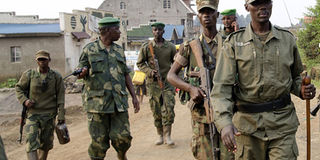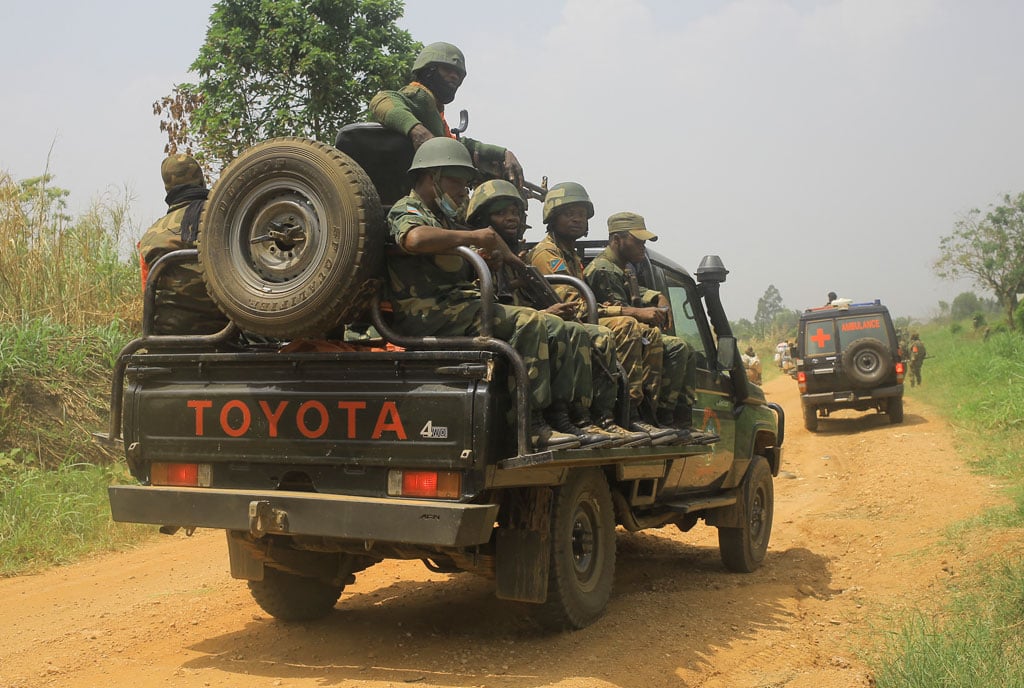Prime
M23 attack awakens spectre of violence in North Kivu

M23 commander Col Sultani Makenga (right) and his body guards tour Bunagana, a town near the Ugandan border, on July 8, 2012. PHOTOS | AFP
What you need to know:
- M23 rebel attack brings to the fore a complex terrain — the ever-changing frontlines, fickle alliances, proxy militias and regional interests in this restive part of the DR Congo.
The M-23 rebels have launched attacks in the flashpoint region of Rutshuru raising fears that the scars of a festering wound in the mineral-rich eastern Democratic Republic of Congo (DRC) are yet to heal.
On the day the neighbouring state joined the East African Community (EAC), fighting in North Kivu province escalated as eight peacekeepers were killed when their helicopter was reportedly shot down while undertaking a reconnaissance mission.
Even as the EAC leaders exchanged pleasantries during a virtual meeting on Monday to welcome DRC to the trading bloc, their faces couldn’t betray a palpable sense of consternation.
The DRC is accusing Rwanda of propping up the rebel group a claim the Kigali government says is false.
This M23 rebel attack brings to the fore a complex terrain — the ever-changing frontlines, fickle alliances, proxy militias and regional interests in this restive part of the country, which have turned North Kivu into a tinderbox.
Uganda’s troops have been holed up at Mukakati in North Kivu province as they hunt down the Allied Democratic Forces (ADF) a Ugandan rebel group that has morphed into the Central Africa caliphate as the ISIS expands its frontiers into the heart of Africa.
However, Rwanda treats North Kivu as a territorial buffer against those seeking to destabilise it.
Before the UPDF deployment, Kishansha had initially considered inviting the armies of Rwanda, Burundi and Uganda into the eastern part of the DRC for each country to deal with specific rebel groups that were destabilising their territories.
But it is not clear yet why the plan was shelved.
Prof Ogenga Otunnu, a history scholar based in the United States, told Daily Monitor in December 2021 shortly after the UPDF was deployed to the DRC that: “The biggest fear at the time was not Uganda, Rwanda, Burundi going to DR Congo, it was the possibility of having a proxy war in DR Congo. Rwanda for instance accuses Uganda and Burundi of supporting rebels based in eastern DR Congo. Uganda and Burundi also accuse Rwanda of supporting rebel groups based in eastern Congo. The DR Congo government allowed entry of UPDF in part because it tried to negotiate with the different armed groups in 2018, then it attempted to pursue other rebel groups last year and this year.”
He proffers that perhaps this plan was shelved on the premise that if all the three countries’ armies were deployed it ‘potentially could develop into a full-blown war.’
Mr Timothy Kalyegira, a researcher and journalist, says since the Rwandan Patriotic Front (RPF) came to power in Rwanda 1994, “It has been acutely aware of its vulnerability from the DRC. On and off tensions with Uganda since the late 1990s have made DR Congo that much more important to Rwanda, especially in recent years when Rwanda accused Uganda of supporting the anti-Kigali RNC.”
Kigali had also drawn a line in the sand warning that North-Kivu should be a no-go area for the UPDF.
Rutshuru remains a crowded war-theatre with roaming militias including Uganda’s Allied Democratic Forces, the Nduma Defence of Congo-Renovated (NDC-R), and its offshoot factions, which control large swathes of territory, the FPPH rebel group composed of the Congolese Hutu community, AFRC led by Charles Bakande, a former member of the Mai Mai militia who has drawn support from the Nande community and runs extortion rackets along the southern shore of Lake Edward taxing lucrative fishing camps and Mazembe-Apasiko led by David Kiboko, the grandchild of Fabien Mudoghu, the former leader of the Front de Résistance Populaire de Lubwe-Rwenzori (FRPL-R) amongst other rebel groups.
North Kivu’s tracts of land have also been parcelled out amongst militias that exploit its mineral wealth and warlords who run extortion and local taxation schemes, especially in the territories of Walikale, Masisi, Rutshuru, Lubero and Beni where minerals such as gold, diamonds, wolfram, cassiterite and coltan are exploited.
The wealth buried in the bowels of earth has barely enriched the local population but only brought death and despair to communities in North Kivu.
The M23 rebellion sprouted in April 2012 in Rutshuru, North Kivu when hundreds of largely ethnic Tutsi soldiers of FARDC, the national army, mutinied over appalling living conditions and poor pay. Most of the mutineers had been members of the National Congress for the Defence of the People (CNDP) another armed group that in 2009 signed a deal with the government, which the dissidents felt Kinshasa had not fully implemented. M23 is named after the date the agreement was signed.
In November 2013, M23 captured the provincial capital of North Kivu, Goma a lakeside city, which lies at the intersection of Rwanda and DRC.
Report on rebel group
A UN panel of experts report released in October 2012 accused the rebel group of working directly under the overall command of Rwanda’s Defence minister with the backing of Uganda, accusations both Kigali and Kampala governments rejected.
“Rwandan officials exercise overall command and strategic planning for M23,” the report said.
“Rwanda continues to violate the arms embargo through direct military support to M23 rebels, facilitation of recruitment, encouragement and facilitation of FARDC [Congolese army] desertions as well as the provision of arms and ammunition, intelligence, and political advice.”
“While Rwandan officials coordinated the creation of the rebel movement as well as its major military operations, Uganda’s more subtle support to M23 allowed the rebel group’s political branch to operate from within Kampala and boost its external relations,” read the 44-page report.
By the end of November 2012, the conflict had forced more than 140,000 people to flee their homes, according to the UN refugee agency.
On November 15, MONUSCO helicopter gunships were deployed to support government forces as they fought to hold off a rebel attack south of Kibumba, flying 17 sorties and firing more than 500 rockets and missiles. The combined army and UN assault killed approximately 64 M23 fighters.

Members of the M23 rebel group in eastern DR Congo on July 23, 2012.
However, the rebels resumed their offensive the next day and in larger numbers; their advance put them within 18 miles of Goma. The army retreated under heavy fire to the southern outskirts of Kibumba after being forced back by the rebels, according to the provincial governor.
The government army began to regroup around the nearby town of Kilimanyoka after the retreat. Later rebels claimed to have seized control of Kibumba but said they had no plans of attacking Goma.
On February 24, 2013, leaders of 11 African nations signed an agreement designed to bring peace to the eastern region of the DR Congo.
On March18, 2013, M23 leader Bosco Ntaganda whose cruelty and violence earned him a nickname Terminator turned himself in to the US embassy in Kigali, Rwanda, where he requested transfer to the International Criminal Court in The Hague.
Though the reasons for his surrender are unknown it was speculated that he was either pressured to do so by Rwanda or feared infighting within the M23 movement and its military leader Sultani Makenga, which had recently forced Ntaganda’s forces to flee the DRC into Rwanda.
Ntaganda was in 2019 sentenced by ICC to 30 years in prison for war crimes and crimes against humanity.
Although some M23 elements surrendered in the Democratic Republic of the Congo and some retreated to Rwanda, on November 5 the bulk of the remaining force under Sultani Makenga crossed into Uganda.
According to a January 22, 2014 letter from the Coordinator of the Group of Experts on the DRC addressed to the President of the Security Council, 14 men were recruited in Uganda following the acceptance of false offers of employment.
Of these men, 13 were Ugandan citizens and 1 was Burundian. Between January 1 and December 8 2013, MONUSCO repatriated 23 Ugandan citizens who had been members of M23.
The group of experts report claims that M23 maintained a recruiting network in Kampala that promised men lucrative jobs as security guards with the United Nations or oil exploration companies in the DRC or jobs as drivers or mechanics. Ex-combatants identified “Mufuruki” “Grace”, “Emmanuel” and “Agnes” as the main recruiters in Uganda.
Several men recruited this way had previously served as security guards at United States installations in Iraq and had been specifically recruited because they had some military training.
Recruiters would assemble groups of 10 to 15 men who had accepted offers of employment and accompany them on a bus from Kampala to Kisoro District, close to the border with the DRC.
In Kisoro, Kazungu, an M23 officer would receive them and escort them across the border. In Bunagana, M23 members took the identification documents, telephones and money from the men and then sent them to Rumangabo to undergo training.
The group interviewed three men who had served in Iraq, one of whom told the group that he and three other Iraq veterans had initially resisted and demanded to go back to Uganda but relented after being threatened at gunpoint.




